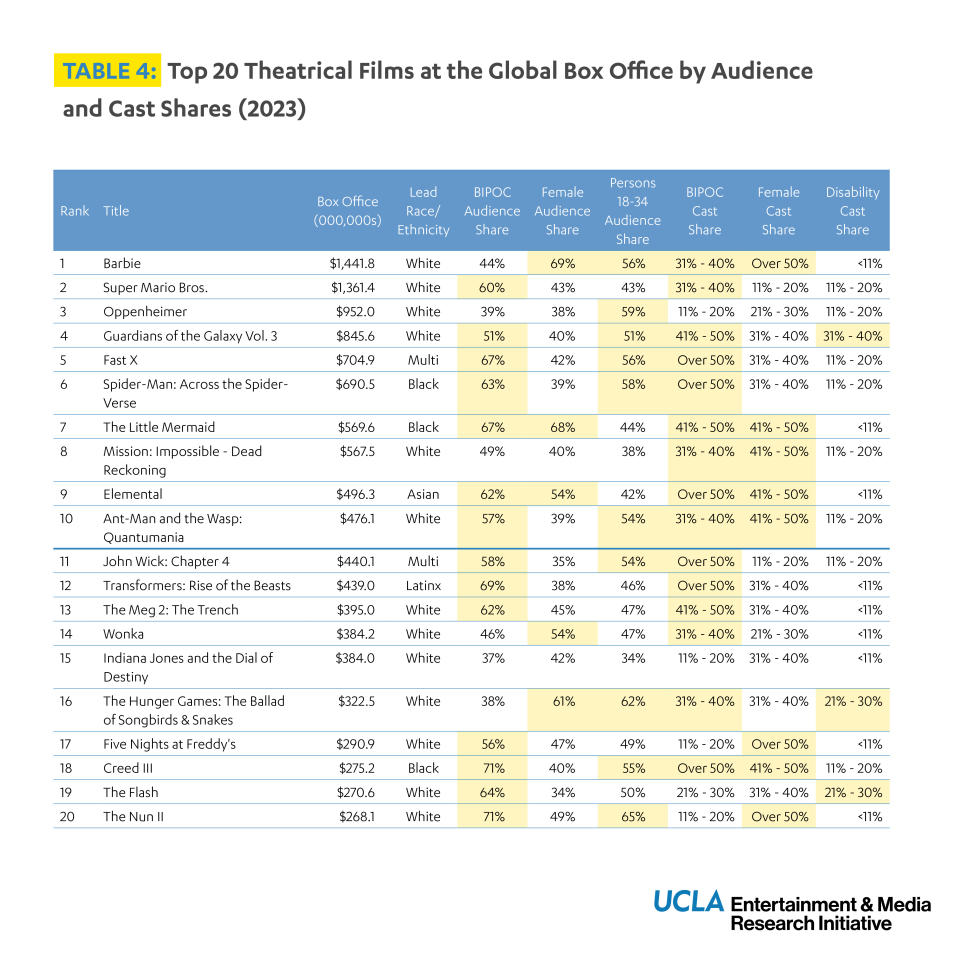Despite ‘Barbie’ Success and Gains for BIPOC Creatives, Hollywood Has an ‘Industry-Wide Commitment Problem with Diversity,’ Study Shows

The latest UCLA Hollywood Diversity report found that diversity is key to ticket sales, noting that BIPOC audiences and women drove the biggest box office winners in 2023.
According to the study, films like “Barbie” and “The Hunger Games: The Ballad of Songbirds & Snakes” — which featured casts comprising 31-40% people of color — had the highest median global box office earnings ($119.8 million) among the top 200 films of the year, indicating that diversity drives demand for movies.
More from Variety
Women, People of Color Make Gains in Writers Rooms But White Men Dominate TV's Biggest Budgets
How BIPOC Audiences Drive Moviegoing: UCLA Hollywood Diversity Report
Audiences Prefer Films With Diverse Casts, According to UCLA Study
Researchers noted that audiences of color dominated opening weekend sales for 14 of the top 20 films, particularly when those casts included or were led by people of color. “Creed III,” “Scream VI” and “John Wick: Chapter 4,” which featured notably diverse casts, were the highest earners in their franchises; BIPOC audiences made up at least 60% of each film’s opening weekend domestic audience. Meanwhile, women led ticket sales for three of the top 10 films, accounting for 69% of opening weekend domestic sales for “Barbie,” 68% for “The Little Mermaid” and 54% for “Elemental.”
“After examining global and domestic box office success and audience demographics for more than a decade, we have repeatedly found that people want to see films that reflect the diversity that exists in their communities and in the world,” said Ana-Christina Ramón, co-founder of the report and director of UCLA’s Entertainment and Media Research Initiative.
Now in its 11th year, the Hollywood Diversity Report, which covers the top English-language theatrical films of 2023, reiterated the importance of diverse audiences as the movie industry aims to bounce back from pandemic-era stressors and the impact of the historic WGA and SAG-AFTRA strikes.
Part one of the report examines 109 of 2023’s top-grossing films to consider the racial/ethnic identity, gender identity and disability status of of lead talent; overall cast diversity; writer and director diversity; genre; box office and domestic ticket buyer demographics. (Part two will analyze streaming releases and will be published later this year.)
“Our reports can’t emphasize this enough: films that embrace diversity are more likely to resonate with audiences, leading to box office success and ultimately long-term sustainability for the industry,” added Darnell Hunt, UCLA’s executive vice chancellor and provost, and co-founder of the report.

Take “Barbie” for example. The study analyzes the $1.4 billion-grossing film from producer-star Margot Robbie and director Greta Gerwig, noting that key to “Barbie’s” success were women, who “packed theaters and made up almost 70% of its domestic ticket sales” in its opening weekend. “But even as ‘Barbie’ broke box office records, the industry demonstrated that it had continued to undervalue movies centering on and led by women.”
On camera, women accounted for 32.1% of film leads in 2023, dropping more than 6% from the 2022 figure, continuing a downward trend that began in 2019. In terms of representation behind the camera, men held on to both the most directing opportunities and the highest budgets. Only 16 films out of the top 200 were directed by women (14.7%, virtually even with 2022’s figure) and just five of those were directed by women of color. White women directors are the most likely to have the smallest budgets, with Gerwig as one of only three women to direct a movie released in 2023 with a budget of $100 million or more, compared to 25 that were helmed by men.
“This is a wake-up call for Hollywood,” said Ramón regarding the potential “Barbie” effect. “Studios need to invest in women and their stories. Women creators and moviegoers are integral to the industry’s growth.” Hunt shared a sharp rebuke regarding the state of things: “There’s an industry-wide commitment problem with diversity.”
On a more positive note, the study indicated a spike in representation for lead actors, directors and writers of color, which each reported the largest shares in each of those categories in the report’s history. The share of theatrical films directed by people of color, like Michael B. Jordan’s “Creed III,” hit 22.8%. That figure is up 6% from last year and nearly double the 2011 figure. Also, films featuring casts in the “most diverse interval” (made up 50% or more by people of color) outnumbered less-diverse films.
“The question is if this upward trend of diversity will continue,” Hunt said. “These gains are most likely a result of the projects greenlit three years ago. We’re in a very different and politicized place, and as the efforts and executives who championed inclusivity and equity disappear from studios, will the next three to five years show a freefall in terms of diversity in Hollywood?”
Actors with disabilities also gained ground, in shares of all theatrical roles (7.1%) and as leads (11.3%), up around 2 percentage points from last year. Given adults with a disability comprise approximately 26 percent of the U.S. population, the group remains severely underrepresented on camera.
The same is true for Latinx creatives: only five of the top films featured Latinx leads, and of the four Latinx writers and four Latinx directors ranking in the top 200, none were women. Native representation was even worse. There were zero Native leads in the top theatrical films, with only 10 Native actors counted among the top credited actors in the overall cast, and none were directed or written by a Native person.
The study ends with a stern warning: “If Hollywood sacrifices the progress it made on diversity, how will it sustain itself?” the researchers write. “Any new version of Hollywood needs to prioritize investing in diversity in front of and behind the camera. If movie studios disregard the findings from this report series that highlight the importance of giving increasingly diverse audiences the films they want to see, they do so at their own peril.”
The full Hollywood Diversity report is available here.
Best of Variety
Sign up for Variety’s Newsletter. For the latest news, follow us on Facebook, Twitter, and Instagram.

